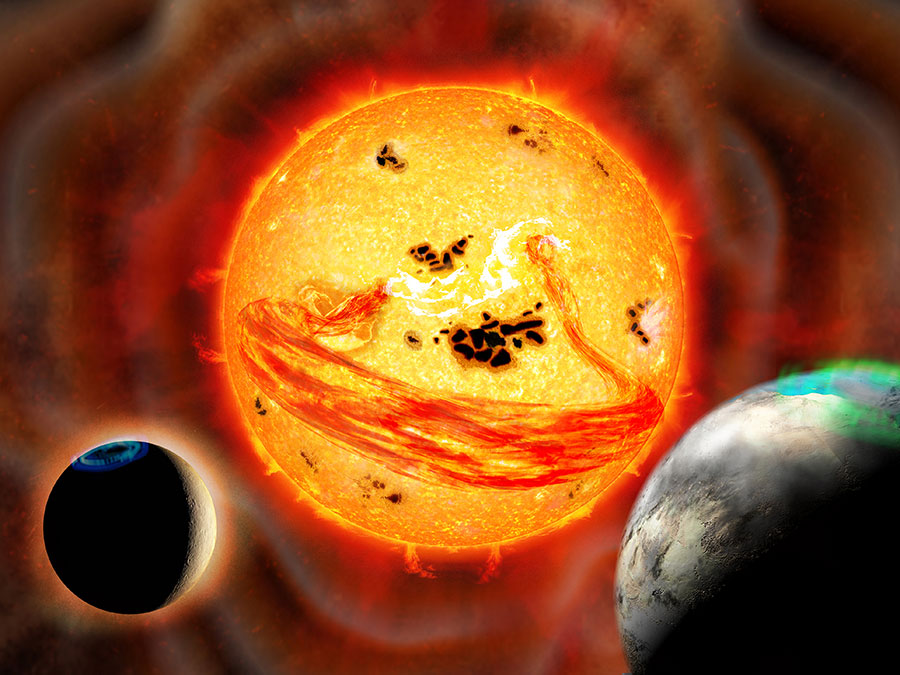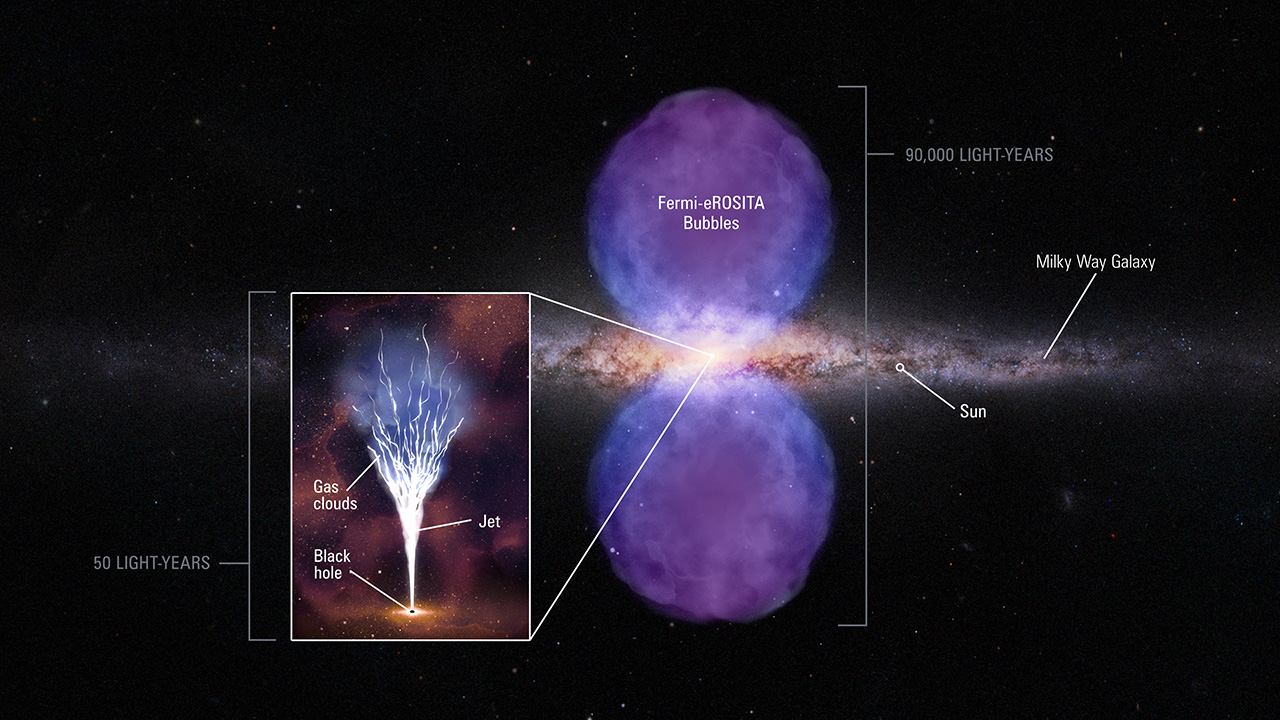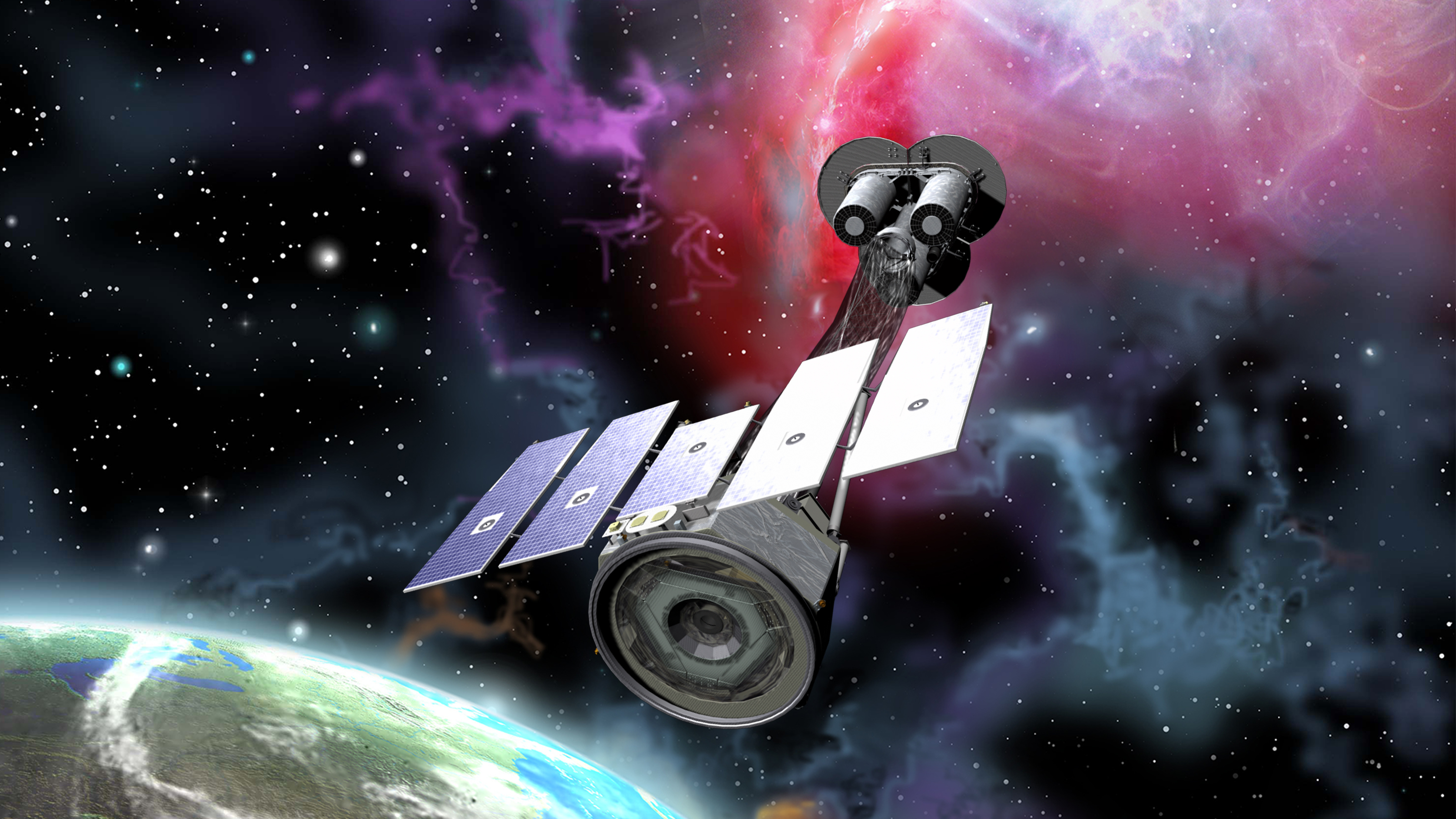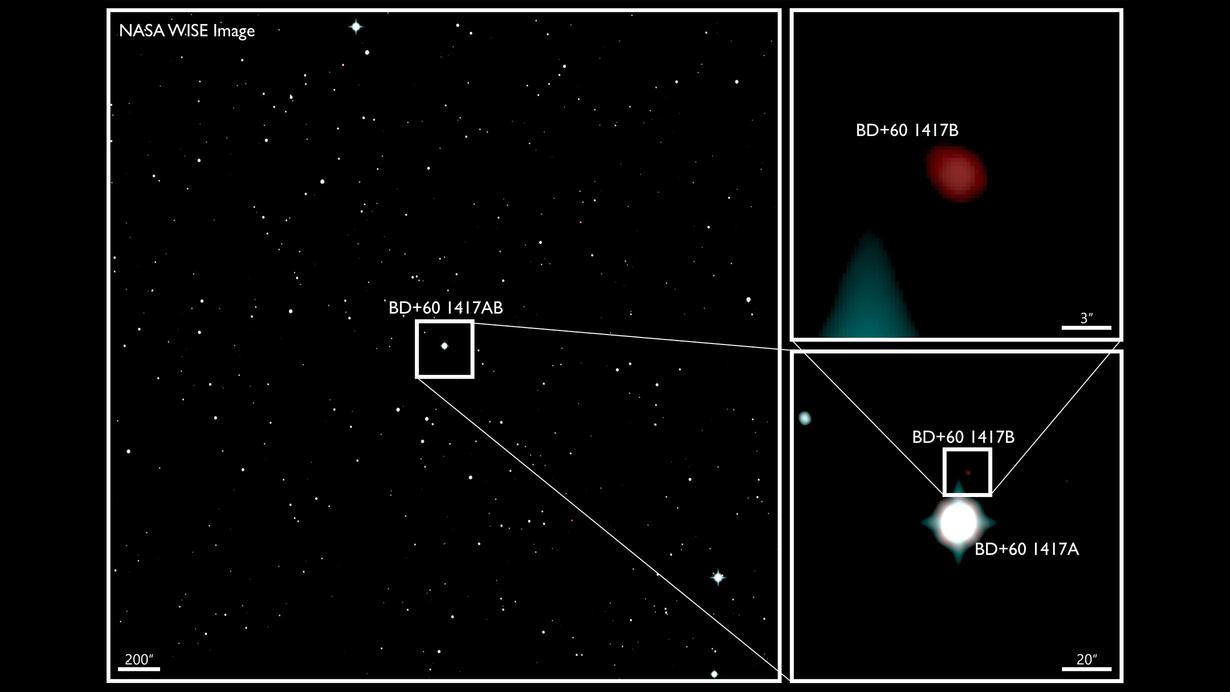Using data provided by the Backyard Worlds: Planet 9 citizen science project, volunteers found a possible large planet or brown dwarf orbiting its star at a distance of more than 1,600 astronomical units. Plus, NASA launches the Imaging X-ray Polarimetry Explorer, and we review Ghostbusters: Afterlife.
Podcast
Show Notes
Sun-like star plasma lashes its solar system
- NAOJ press release
- “Probable detection of an eruptive filament from a superflare on a solar-type star,” Kosuke Namekata et al., 2021 December 9, Nature Astronomy
The Milky Way’s black hole is a messy eater
- Hubble press release
- “Tracing the Milky Way’s Vestigial Nuclear Jet,” Gerald Cecil et al., 2021 December 6, The Astrophysical Journal
Melting poles emit methane
- “Characterizing methane emission hotspots from thawing permafrost,” C. D. Elder et al., 2021 December 2, Global Biogeochemical Cycles
Falcon 9 takes left turn at equator for NASA
- SpaceX media kit (via Archive Today)
- PDF: IXPE Mission System Concept and Development Status (NASA)
- X-ray Telescopes Introduction (NASA)
Overlooked exoplanet found by citizen scientists
- AMNH press release
- “A Wide Planetary Mass Companion Discovered through the Citizen Science Project Backyard Worlds: Planet 9,” Jacqueline K. Faherty et al., 2021 December 9, The Astrophysical Journal
Transcript
Hello and welcome to the Daily Space. I am your host Dr. Pamela Gay.
I am your host, Beth Johnson. And we will be joined by Erik Madaus to talk launches later in the show.
Together, we are here to put science and rockets in your brain.
A lot of times, our news stories make us think it would be good to exit our solar system and get as far away from Earth as possible. Not today’s first two stories. They make me kind of glad that we are right where we are.

Astronomers studying the star EK Draconis recently observed it undergo a massive flare and emit a massive filament of plasma. The outburst was ten times larger than anything we’ve seen our Sun eject, and it was moving at a zippy 500 km/s.
While massive flares are nothing new, especially for young red dwarf stars, this particular flare was of note because EK Draconis is a Sun-like star. It’s much younger than the Sun but is similar in mass. This leads to the uncomfortable realization that our Sun, when it was young, probably also had these occasional superflares.
Superflares that could be very bad for planets like Earth.
These results appear in Nature Astronomy and are published with lead author Kosuke Namekata. While our modern Sun shouldn’t still be capable of these kinds of wild outbursts, I have to admit that the part of my brain that is aware the Universe is more creative than we are holds onto a small amount of worry. Luckily, we have spacecraft between us and the Sun that can alert us if any plasma lashes are headed our way, which they shouldn’t be.
“Shouldn’t be.” Well, that gives me so much confidence.
And this brings us to one of the great and terrible things about science. It’s a process, and over time, we often learn that the things we assumed, well, we all know what they say about assumptions.

Let’s take a moment to consider the fact that our galaxy, like all similar galaxies, has a supermassive black hole in its core. This black hole is smaller in volume than the planet-having parts of our solar system and packs in four million Suns’ worth of mass. As long as things are on stable orbits, there is no danger they’ll get sucked into that behemoth – we are in no danger, for instance – but instabilities happen. Sometimes a star gets too close to another star or two, and changed orbits can send things in to feed that black hole.
It had been believed (assumed) that our galaxy wasn’t actively feeding and consumed its last large meal about 2-4 million years ago. In newly analyzed images from the Hubble Space Telescope, it turns out – surprise, surprise – our supermassive black hole is way more active than thought and is currently having a good meal of whatever gas, dust, or stars most recently crossed its event horizon. When it eats, the infalling material generates a powerful magnetic field as it circles in, and researchers can see the jets that the magnetic field is creating. According to coauthor Alex Wagner: The streams percolate out of the Milky Way’s dense gas disk. The jet diverges from a pencil beam into tendrils, like that of an octopus.
These diverging jets are responsible for the soap bubble structure in the inner 500 light-years of our galaxy.
While today’s jet is relatively small and very hard to find, the event that occurred 2-4 million years ago was a million-fold brighter. This implies that just when life emerged on Earth, the constellation Sagittarius glowed with the light – largely blocked by dust – of a feeding black hole.
It kind of makes me hope it feeds again, just so we can watch from where we are, far far away.
The accidental theme of this first segment is apparently “jets in places we didn’t expect them”. A Sun-like star whipped its solar system; the milky way’s supermassive black hole is spewing jets; the Earth’s melting permafrost is belching methane. We knew this last story to a certain extent, but the amount being emitted and expectations for future emissions all got turned up several notches thanks to new measurements.

In a new paper appearing in Global Biogeochemical Cycles, researchers led by C.D. Elder found some regions of the Arctic are giving off as much as 24 grams of methane per square meter per day. Their study focused on the region near a thermokarst lake. The hotspots were associated with areas where the permafrost has recently melted. Using airborne detectors in combination with ground measurements, they determined: Hotspot emissions accounted for ∼40% of total diffusive CH4 emissions from the lake study site.
Methane is a powerful greenhouse gas, and this points to the terrible feedback loop where the melting of some permafrost will release gases that potentially lead to the melting of more permafrost and the release of even more methane, and the paper predicts the emissions will increase non-linearly in our warming climate.
All right, we found our way back to wanting to exit our planet.

On December 9 at 0600 UTC, a SpaceX Falcon 9 launched NASA’s Imaging X-Ray Polarimetry Explorer (IXPE) into equatorial orbit from LC-39A in Florida.
After eight and a half minutes, Booster 1061 landed on the droneship Just Read The Instructions, successfully completing its fifth flight into space.
Back in orbit, the fairings separated, exposing the 300-kilogram satellite to space. Then the second stage shut down and began a 20-minute coast phase. At the second stage restart over the middle of Africa, the Falcon 9 did something remarkable: a 27-degree plane change to almost completely zero out its inclination and circularize the orbit at 600 kilometers. Although this required about 3.5 kilometers of delta velocity, because the second stage was nearly perpendicular to the direction of travel during the burn, the vehicle’s orbital speed hardly changed.
Why go to all of this effort to launch a small satellite? Part of the answer is because of money, as many things are. The mission was originally designed to be launched on a much smaller rocket, a Northrop Grumman Pegasus rocket, from under a plane over the ocean at the equator. Ultimately Pegasus was not selected due to cost, and SpaceX was awarded the mission launching on a much bigger Falcon 9 rocket from Florida.
The other part of the answer is because of the scientific data it is intended to collect: X-rays. The telescope needed to go into a low inclination orbit to avoid the South Atlantic Anomaly (SAA), an area where the lower Van Allen radiation belts get closest to the Earth. Flying through the SAA would interfere with the sensitive detectors. In order to avoid contaminating the instruments, IXPE does not have any propulsion either for pointing or orbital maneuvering. IXPE will decay from orbit in less than 25 years, in compliance with orbital debris regulations.

X-ray telescopes are pretty cool. Because of the high energy of an X-ray photon, it is much more difficult to collect and focus the energy to create an image as they go right through a typical mirror. The mirrors in an X-ray telescope, however, are nearly parallel to the oncoming light, using what is known as grazing incidence to direct the X-ray photons to a focal point behind the mirrors, like a Cassegrain-type telescope.
The parallel mirrors don’t have a lot of surface area along the scope axis so instead of having one big flat(ish) mirror, an X-ray telescope has many nested rings of mirrors like an onion to collect as much light as possible. IXPE’s telescopes have 24 rectangular mirror segments each, arranged around a cylindrical support.
IXPE brings a new way of observing X-rays to orbit. This new mission improves on Chandra by making it possible to measure the orientation – technically called polarization – of the X-ray photons. It also has the ability to simultaneously make spectral, spatial, and time-based measurements. This will allow it to accomplish tasks like determining how pulsars accelerate particles and to measure the magnetic field configuration in magnetars. With IXPE, we’ll have a whole new set of ways to see the higher energy parts of our universe.
During a post-show Q&A the other day, we discussed how the only exoplanet stories we’re getting these days are about the wildest and weirdest planet discoveries. There’s a reason for that. We’ve found nearly 5,000 exoplanets, and the discoveries had gotten to the point where the press releases announcing them became so common that no one was really paying attention to them anymore. Once unusual and exciting, exoplanets are now pretty commonplace. Which has brought us to where the announcements are now about planets with strange orbits or unusual sizes, such as the ones that orbit in less than a day or are Mars-sized.

Today’s press release is no different in that regard. A new paper published in The Astrophysical Journal details the discovery of a massive exoplanet that could be a brown dwarf, orbiting at a huge distance from its star: over 1,600 astronomical units away. Remember, an astronomical unit is the average distance from the Earth to the Sun, so this giant of a planet is 1,600 times farther away. We haven’t found a lot of planets at that type of distance from their host stars.
Now, one of the coolest pieces of this story is that this particular exoplanet was discovered by a volunteer citizen scientist looking at data in the Backyard Worlds: Planet 9 project. Jörg Schümann noticed that a particular object was moving in tandem with a star. Other searches had missed the planet because of that huge distance between the planet and star. Lead author Jackie Faherty explains: This star had been looked at by more than one campaign searching for exoplanet companions. But previous teams looked really close to the star. Because citizen scientists really liked the project, they found an object that many of these direct imaging surveys would have loved to have found, but they didn’t look far enough away from its host.
This project is not one of those “look at light curves and flag dips” projects where we are dealing with exoplanet transits. Backyard Worlds uses data from NASA’s Wide-field Infrared Survey Explorer (WISE) mission, and citizen scientists look through digital images for objects that seem to jump between one image and another. Those objects are then flagged for further analysis.
So what do we know about this planet? It’s about ten to twenty times the mass of Jupiter. That’s kind of interesting considering the cutoff for becoming a brown dwarf is at about thirteen times the mass of Jupiter. This is either a really big gas giant or a brown dwarf. The main way we could tell the difference is if we knew how the object formed. Planets come from material gathering up in protoplanetary disks of dust and gas. Brown dwarfs form like stars, by a collapse of a giant cloud of gas. But we don’t have enough data to conclude, either way, so let’s just say there is a really big world out there.
Citizen science is amazing, as most of our audience knows. We’re hoping to get a new project up and running next year, and we’re also hoping to have the lead author of this paper, Jackie Faherty, on for an interview in January as well. Make sure you’re following us on our social media platforms for announcements of both events.
Review

When it comes to finding things to review, we sometimes debate what works for our audience, and I admit, I hesitated a week or two before asking to review this movie for you. And then I had to justify my request, which I obviously did well since here we are.
Ghostbusters: Afterlife is the latest installment in the Ghostbusters franchise that started nearly thirty years ago with the original film in 1984. That movie was written by Dan Akroyd and Harold Ramis and directed by Ivan Reitman. Unfortunately, we lost Harold Ramis in 2014, which dashed any hopes of a full reunion of the original cast for another sequel. And while the 2016 Ghostbusters was loosely linked to the original films, this latest movie is a direct sequel and follows the story straight into today.
I’m going to do my best to not spoil certain aspects of Afterlife but be forewarned that there will still be spoilers in this review.
We start the movie with a mysterious light and a truck racing away. The person is in shadow, and it turns out, is being chased by something supernatural. Look, the main conceit here is that ghosts are real, so you’ll just have to accept that part. I’m not going to criticize the movie for that. It’s on the tin. But this opening scene gives a hint at some of the science that will come up for the rest of the movie. The mysterious figure flips a switch, electrifying several grain silos, and then presses a pedal where… Nothing happens. The man slips inside the house, locks the door, and sits down, where he meets his supernatural demise. There’s some familiar-looking ghost detecting gear involved, which you’ll recognize from the original movies.
Now we switch to a single mom and her two kids. The oldest, Trevor, played by Finn Wolfhard from Stranger Things, is sixteen. The younger, Phoebe, is a late pre-teen or early teenager. She’s played by McKenna Grace, who frankly steals the entire movie. What struck me about her character is that she is wicked smart, very introverted, and definitely neurodiverse. And they wrote the interactions in such a way that was respectful to her character — no easy jokes at her expense — but a lot of understanding between her and her mom. Phoebe doesn’t make friends easily, she tells jokes badly, and she looks vaguely familiar.
The family is getting evicted from their apartment, and the timing is just right that the mysterious, shadowy figure from the first scene turns out to be the woman’s estranged father, and he’s left them the house and farm, so off they go to try and sell anything they can and move right back.
Narrator: There is nothing really to sell, and they don’t move right back.
From here, the movie goes into a supernatural adventure, with a weird mountain, a deserted mine, and a possible apocalypse level event in the making. It’s just like New York in 1984, and it turns out that the mysterious figure is Egon Spangler, played all shadowy since Harold Ramis passed away. We get absolutely zero mention of Trevor and Phoebe’s dad or Egon’s past love interest. Zero. So don’t expect any answers there.
Trevor fixes up Ecto-1, which is in a dilapidated barn. Phoebe starts playing chess with the ghost of Egon. Paul Rudd shows up as the summer school teacher who has no interest in teaching a room full of reprobates, so he’s letting them watch classic horror movies while working on his geology research in the next room. Earthquakes have become commonplace in this small town in Oklahoma, and the science here was pretty decently explained. Yay for a geologist in a movie!
Also, he becomes the love interest of the mom, which is important, and if you know the original film well, you may understand why without me explaining.
I could give a whole lot away about this film for the sake of commenting on the science and technology. Let’s just say it’s good. It didn’t take me out of the film at all. Phoebe is really, really smart, and she works on some of the old ghost-busting tech. Egon is an invisible ghost, guiding as best he can.
One of the big themes in this movie is how people don’t listen to scientists but also how sometimes, scientists don’t communicate well. Remember, Egon was the brains of the original group, and his poor communication skills are what led to him being alone in Oklahoma. Phoebe has difficulty making friends because science is what’s on her mind. She first makes friends with Paul Rudd, the scientist teacher in her world who is actually working on something cool. And she manages to find a friend who thinks her terrible jokes are hilarious. He’s a podcaster called, well, “Podcast”, and his show focuses on conspiracy theories and the supernatural. Of course.
The dialog is smart. People communicate. There are a ton of callbacks to the first movie, including watching the original ad for the Ghostbusters on YouTube. Nice touches that will definitely bring the nostalgia. There are also great cameos, and I won’t spoil those.
Overall, if you can suspend disbelief about ghosts and gods and weird apocalypse events, if you’re a fan of the original Ghostbusters franchise, then I highly recommend this movie. If you’ve never seen the original movies, which was the case with my kid, you’ll still enjoy it, but you might not get all the little references sprinkled everywhere.
Oh, and make sure you stay all the way through the credits. There are two stingers on this one.
This has been the Daily Space.
You can find more information on all our stories, including images, at DailySpace.org. As always, we’re here thanks to the donations of people like you. If you like our content, please consider joining our Patreon at Patreon.com/CosmoQuestX.
Credits
Written by Pamela Gay, Beth Johnson, and Erik Madaus
Hosted by Pamela Gay, Beth Johnson, and Erik Madaus
Audio and Video Editing by Ally Pelphrey
Content Editing by Beth Johnson
Intro and Outro music by Kevin MacLeod, https://incompetech.com/music/


 We record most shows live, on Twitch. Follow us today to get alerts when we go live.
We record most shows live, on Twitch. Follow us today to get alerts when we go live.